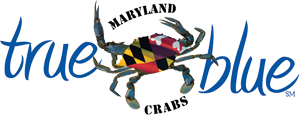|
Maryland Crab Coming to a Restaurant Near You
Daniel Strain

Logo courtesy of Steve Vilnit
THE FUTURE OF THE MARYLAND CRAB INDUSTRY may depend in part on whether real Maryland crab makes it onto the menu at your local restaurant. That's the idea behind the "True Blue" campaign, a new marketing effort by the state of Maryland celebrating local restaurants that offer Chesapeake-caught crab.
The campaign aims to educate diners about a little-known reality in Maryland's hospitality industry: while crab cakes are a signature Chesapeake dish, many eateries in Maryland now make their cakes from imported, not local, seafood. "I know people who have lived in Maryland for a long time and go out all the time, and they've never eaten Maryland crab in their life," says Chad Wells, executive chef of the Baltimore-based eatery Alewife. After all, Asian crab meat costs restaurateurs dollars less per pound, and many customers never notice the switch. But Wells says that if you pay attention, the differences are clear. Chesapeake crabs come with a rich, buttery-sweetness, he notes, courtesy of the fat stores the animals build up to survive cold winters on the Bay. Asian crabs, he says, don't.
The True Blue effort is meant to educate restaurant-goers about which establishments sell locally harvested crab, says Steve Vilnit, the man behind the campaign. He's director of fisheries marketing for the Maryland Department of Natural Resources. Vilnit's plan is simple: restaurants like Alewife that buy at least three-quarters of their crab meat from local sources will be entitled to print the True Blue logo on their menus — a blue crab emblazoned with the Maryland state flag on its shell. As of late June, nearly 40 eateries, including Baltimore's Woodberry Kitchen and Washington's Dino, had submitted applications to the program. Roughly the same number of retail stores, such as some Whole Foods locations, will also participate.
Vilnit adds that there's more to the campaign than just promoting good taste. "It isn't just about the product that shows up at their back door," he says. "It's about the work that goes into it. " To help chefs better understand the effort that goes into each pound of crab meat, he's given about three dozen tours of the Chesapeake Bay to Maryland epicures over the past 18 months. He encourages them to leave behind their busy kitchens and markets and spend the day on a working fishing boat, with a possible stop later at a seafood processing plant.
Many chefs seem to appreciate this introduction to seafood's supply-side, too. Wells, a True Blue participant, has traveled out to the Eastern Shore with Vilnit several times already. He keeps coming back because, like many foodies, he has an almost geeky need to know where the ingredients he cooks come from. This year, for instance, he saw for the first time crab pickers at work at the J.M. Clayton Company in Cambridge, Maryland — and, he admits, they put him to shame. "They can pick a crab in 10 seconds. ...It's unbelievable to see," Wells says. "I can't even do it in 5 minutes."
|